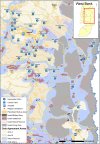Can a midwife-led continuity model improve maternal services in a low-resource setting? A non-randomised cluster intervention study in Palestine
- PMID: 29567846
- PMCID: PMC5875636
- DOI: 10.1136/bmjopen-2017-019568
Can a midwife-led continuity model improve maternal services in a low-resource setting? A non-randomised cluster intervention study in Palestine
Abstract
Objectives: To improve maternal health services in rural areas, the Palestinian Ministry of Health launched a midwife-led continuity model in the West Bank in 2013. Midwives were deployed weekly from governmental hospitals to provide antenatal and postnatal care in rural clinics. We studied the intervention's impact on use and quality indicators of maternal services after 2 years' experience.
Design: A non-randomised intervention design was chosen. The study was based on registry data only available at cluster level, 2 years before (2011and2012) and 2 years after (2014and2015) the intervention.
Setting: All 53 primary healthcare clinics in Nablus and Jericho regions were stratified for inclusion.
Primary and secondary outcomes: Primary outcome was number of antenatal visits. Important secondary outcomes were number of referrals to specialist care and number of postnatal home visits. Differences in changes within the two groups before and after the intervention were compared by using mixed effect models.
Results: 14 intervention clinics and 25 control clinics were included. Number of antenatal visits increased by 1.16 per woman in the intervention clinics, while declined by 0.39 in the control clinics, giving a statistically significant difference in change of 1.55 visits (95% CI 0.90 to 2.21). A statistically significant difference in number of referrals was observed between the groups, giving a ratio of rate ratios of 3.65 (2.78-4.78) as number of referrals increased by a rate ratio of 3.87 in the intervention group, while in the control the rate ratio was only 1.06.Home visits increased substantially in the intervention group but decreased in the control group, giving a ratio of RR 97.65 (45.20 - 210.96) CONCLUSION: The Palestinian midwife-led continuity model improved use and some quality indicators of maternal services. More research should be done to investigate if the model influenced individual health outcomes and satisfaction with care.
Trial registration number: NCT03145571; Results.
Keywords: continuity of care; low- middle income country; maternal care; midwifery; organisation of health services; quality in health care.
© Article author(s) (or their employer(s) unless otherwise stated in the text of the article) 2018. All rights reserved. No commercial use is permitted unless otherwise expressly granted.
Conflict of interest statement
Competing interests: None declared.
Figures
References
-
- World Bank. Country information. http://data.worldbank.org/country/west-bank-and-gaza (accessed Sep 2017).
-
- Palestine Ministry of Health. Palestine Ministry of Health Annual Report 2013. Palestine, Nablus, 2013.
-
- Palestinian Central Bureau of Statistics. Palestinian Multiple Indicator Cluster Survey 2014, Final Report. Ramallah, Palestine, 2015.
Publication types
MeSH terms
Associated data
LinkOut - more resources
Full Text Sources
Other Literature Sources
Medical


